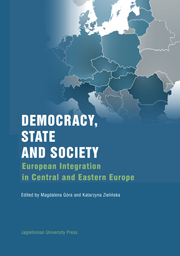Book contents
- Frontmatter
- Contents
- List of contributors
- Europeanisation in the EU New Member States. Aspects and Research Agendas
- Part one Democracy after Enlargement
- Part two Identity Transformations
- Part three Civil Society Organisations in Central and Eastern Europe
- Part four Europeanisation of International Relations
- The Changing Nature of Foreign Policy and International Relations in Central and Eastern Europe
- From Existential Politics Towards Normal Politics? The Baltic States in the Enlarged Europe
- Poland's Power and Influence in the European Union: The Case of Its Eastern Policy
- Visegrad Group Cooperation and “Europeanisation” of New EU Member States
- Index
Poland's Power and Influence in the European Union: The Case of Its Eastern Policy
from Part four - Europeanisation of International Relations
Published online by Cambridge University Press: 05 September 2014
- Frontmatter
- Contents
- List of contributors
- Europeanisation in the EU New Member States. Aspects and Research Agendas
- Part one Democracy after Enlargement
- Part two Identity Transformations
- Part three Civil Society Organisations in Central and Eastern Europe
- Part four Europeanisation of International Relations
- The Changing Nature of Foreign Policy and International Relations in Central and Eastern Europe
- From Existential Politics Towards Normal Politics? The Baltic States in the Enlarged Europe
- Poland's Power and Influence in the European Union: The Case of Its Eastern Policy
- Visegrad Group Cooperation and “Europeanisation” of New EU Member States
- Index
Summary
Abstract: This paper seeks to assess the degree to which Poland exercises power and influence in the European Union. It employs Poland's policy towards its eastern neighbours as a case study, and, in doing so, contributes to two wider scholarly debates on how EU policy towards Russia, Ukraine and Belarus is made, and also the broader question of the evolving nature of the relationship between the European Union and its member states. In doing so, it employs a synthetic framework that brings together the approaches for studying the power and influence of a given member state that were developed by Wallace et al. (2005), Tallberg (2008) and Moravcsik (1991, 1993, 1998). It concludes that Polish influence has been low.
Introduction
Poland is the largest of the member states that joined the European Union (EU) in the enlargements of 2004 and 2007. With half the total population and economic weight of the accession countries, in some respects the eastern enlargement of the European Union was a “Polish enlargement”. It could be hypothesised that this significant expansion of the Union from a predominantly West European club of 15 member states to a pan-European Union of 27 diverse member states would have a major impact on the governance, politics, policies and overall agenda of the European Union.
- Type
- Chapter
- Information
- Democracy, State and SocietyEuropean Integration in Central and Eastern Europe, pp. 271 - 292Publisher: Jagiellonian University PressPrint publication year: 2011



